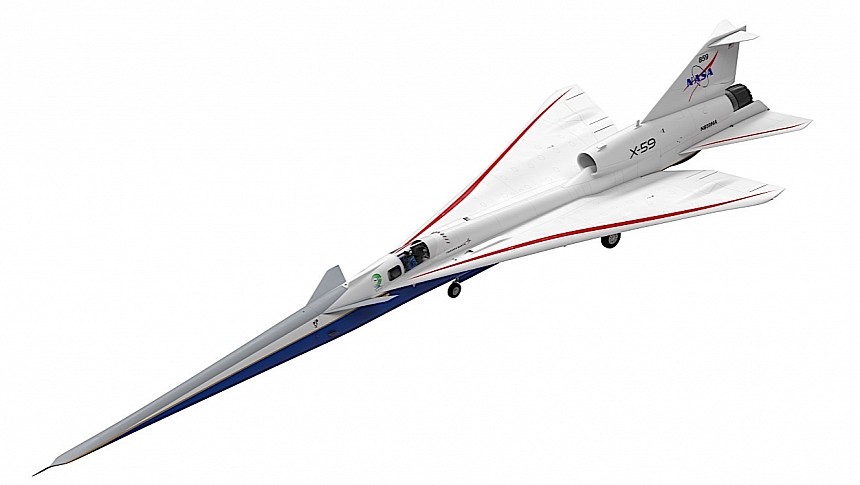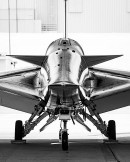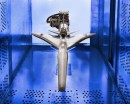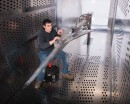About a month ago we got a piece of news that kind of disappointed us: the first flight of the X-59 Quiet SuperSonic Tecnology (QueSST) aircraft was no longer to take place this year, but got pushed to the next one.
The X-59 is the demonstrator NASA plans to use to advance its research into a new kind of aircraft design. One that, if successful and applied to commercial airplanes, might just bring back supersonic passenger travel, even over populated areas.
That's because it will use a design meant to separate the pressure waves shocks and expansions associated with supersonic flight, effectively reducing the amount of noise it generates from 78 dB at over 8,000 meters altitude to as little as 60 dB, the average volume of a conversation between friends. A sonic thump, as NASA calls it.
The delay of the first flight occurred because of the technical difficulties encountered when putting the plane together. That's because the X-59 is not entirely made from scratch, but uses a series of bits and pieces taken from other planes as well: the cockpit of a T-38 Talon trainer aircraft, the landing gear of an F-16, and the life support system of the F-15.
When we last reported on the QueSST back in October the plane was undergoing mandatory pre-flight integrated testing, and was scheduled for a flight readiness review. Somewhere in between, a paint job had to be performed.
And guess what? That's exactly what the aircraft is currently doing: getting new colors. As per NASA, it was moved to the paint barn of the Lockheed Martin Skunk Works' facility in California.
When finished, the aircraft will come in a mostly white body, but with an underside in sonic blue. The wings will sport red accents, effectively bringing all the colors of Old Glory.
As it often happens in the aviation industry, the colors are not there only for show. The properties of the paint used help with protection against moisture and corrosion, and it also comes with markings meant to "assist with ground and flight operations."
The paint job will be followed by something you'd never think is done in the aviation industry: the plane will be measured and weighed. That will help NASA and Lockheed Martin people improve the computer modeling of the X-59.
Sometime in 2024 (the exact date is yet to be announced) the QueSST will take flight over several U.S. communities (the locations will be made public at a later date) in a bid to gather data on how people perceive the plane and how the sound it makes affects them.
The data gathered this way will be shared with regulators in a bid to help them adjust the rules that presently prevent supersonic aircraft from flying at their top speed over land.
That's because it will use a design meant to separate the pressure waves shocks and expansions associated with supersonic flight, effectively reducing the amount of noise it generates from 78 dB at over 8,000 meters altitude to as little as 60 dB, the average volume of a conversation between friends. A sonic thump, as NASA calls it.
The delay of the first flight occurred because of the technical difficulties encountered when putting the plane together. That's because the X-59 is not entirely made from scratch, but uses a series of bits and pieces taken from other planes as well: the cockpit of a T-38 Talon trainer aircraft, the landing gear of an F-16, and the life support system of the F-15.
When we last reported on the QueSST back in October the plane was undergoing mandatory pre-flight integrated testing, and was scheduled for a flight readiness review. Somewhere in between, a paint job had to be performed.
And guess what? That's exactly what the aircraft is currently doing: getting new colors. As per NASA, it was moved to the paint barn of the Lockheed Martin Skunk Works' facility in California.
When finished, the aircraft will come in a mostly white body, but with an underside in sonic blue. The wings will sport red accents, effectively bringing all the colors of Old Glory.
As it often happens in the aviation industry, the colors are not there only for show. The properties of the paint used help with protection against moisture and corrosion, and it also comes with markings meant to "assist with ground and flight operations."
The paint job will be followed by something you'd never think is done in the aviation industry: the plane will be measured and weighed. That will help NASA and Lockheed Martin people improve the computer modeling of the X-59.
Sometime in 2024 (the exact date is yet to be announced) the QueSST will take flight over several U.S. communities (the locations will be made public at a later date) in a bid to gather data on how people perceive the plane and how the sound it makes affects them.
The data gathered this way will be shared with regulators in a bid to help them adjust the rules that presently prevent supersonic aircraft from flying at their top speed over land.










